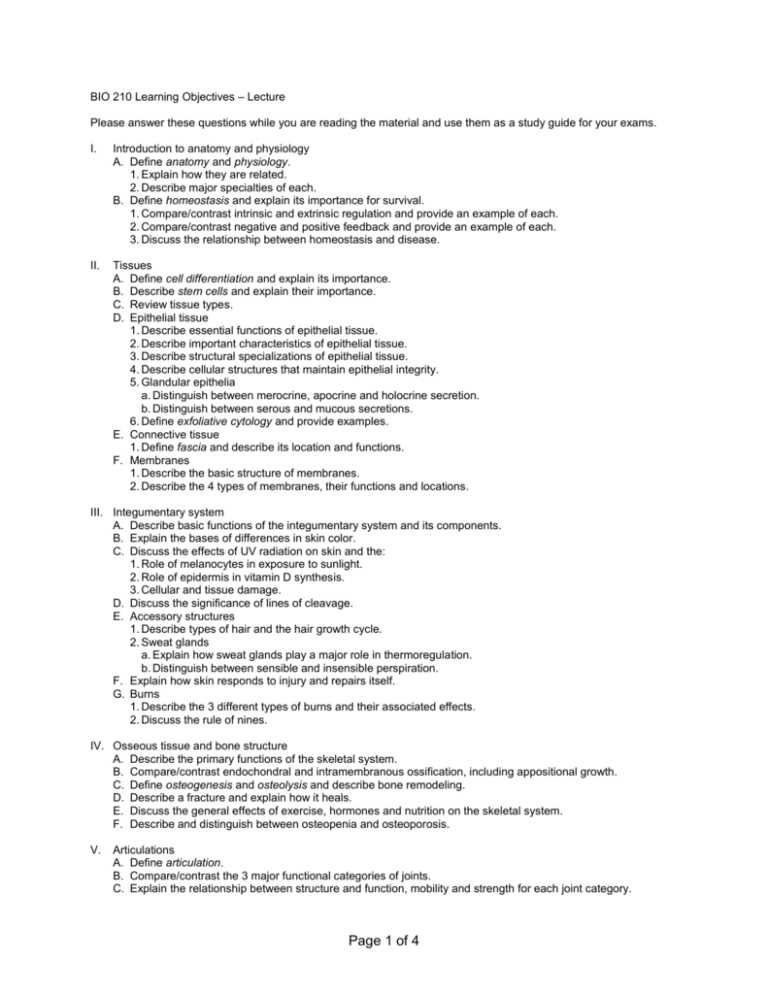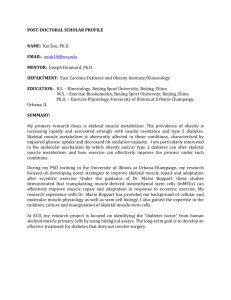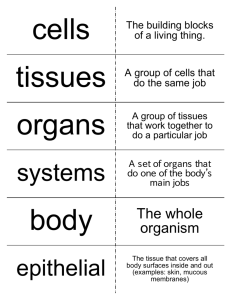BIO 210 Course Outline
advertisement

BIO 210 Learning Objectives – Lecture Please answer these questions while you are reading the material and use them as a study guide for your exams. I. Introduction to anatomy and physiology A. Define anatomy and physiology. 1. Explain how they are related. 2. Describe major specialties of each. B. Define homeostasis and explain its importance for survival. 1. Compare/contrast intrinsic and extrinsic regulation and provide an example of each. 2. Compare/contrast negative and positive feedback and provide an example of each. 3. Discuss the relationship between homeostasis and disease. II. Tissues A. Define cell differentiation and explain its importance. B. Describe stem cells and explain their importance. C. Review tissue types. D. Epithelial tissue 1. Describe essential functions of epithelial tissue. 2. Describe important characteristics of epithelial tissue. 3. Describe structural specializations of epithelial tissue. 4. Describe cellular structures that maintain epithelial integrity. 5. Glandular epithelia a. Distinguish between merocrine, apocrine and holocrine secretion. b. Distinguish between serous and mucous secretions. 6. Define exfoliative cytology and provide examples. E. Connective tissue 1. Define fascia and describe its location and functions. F. Membranes 1. Describe the basic structure of membranes. 2. Describe the 4 types of membranes, their functions and locations. III. Integumentary system A. Describe basic functions of the integumentary system and its components. B. Explain the bases of differences in skin color. C. Discuss the effects of UV radiation on skin and the: 1. Role of melanocytes in exposure to sunlight. 2. Role of epidermis in vitamin D synthesis. 3. Cellular and tissue damage. D. Discuss the significance of lines of cleavage. E. Accessory structures 1. Describe types of hair and the hair growth cycle. 2. Sweat glands a. Explain how sweat glands play a major role in thermoregulation. b. Distinguish between sensible and insensible perspiration. F. Explain how skin responds to injury and repairs itself. G. Burns 1. Describe the 3 different types of burns and their associated effects. 2. Discuss the rule of nines. IV. Osseous tissue and bone structure A. Describe the primary functions of the skeletal system. B. Compare/contrast endochondral and intramembranous ossification, including appositional growth. C. Define osteogenesis and osteolysis and describe bone remodeling. D. Describe a fracture and explain how it heals. E. Discuss the general effects of exercise, hormones and nutrition on the skeletal system. F. Describe and distinguish between osteopenia and osteoporosis. V. Articulations A. Define articulation. B. Compare/contrast the 3 major functional categories of joints. C. Explain the relationship between structure and function, mobility and strength for each joint category. Page 1 of 4 D. Distinguish between ligament and tendon. E. Synovial joints 1. Describe basic structural components and accessory structures and their functions. 2. Describe and provide an example of each of the following types of synovial joints: gliding, hinge, pivot, ellipsoid, saddle, ball-and-socket. 3. Describe and provide an example of each of the following types of movement: gliding, flexion/extension, abduction/adduction, circumduction, pronation/supination, dorsiflexion/plantar flexion, protraction/retraction, elevation/depression, pivoting F. Distinguish between sprain, strain and luxation. VI. Muscle tissue A. Describe the general functions of skeletal muscle. B. Anatomy of skeletal muscle 1. Describe the organization of skeletal muscle, including connective tissue layers. 2. Name the major cellular components of a skeletal muscle fiber and describe the function of each. 3. Describe the structural components and features of a sarcomere, including thin and thick filaments. C. Identify the components of the neuromuscular junction and summarize the events involved in neural control of skeletal muscles. D. Explain the sliding filament theory and the key steps involved in contraction and relaxation of a skeletal muscle fiber. E. Define tension and its role in muscle function. F. Responses to stimulation 1. Define twitch and describe its characteristics in different muscles. 2. Distinguish between a twitch and the effects generated by repeated stimulation (e.g., treppe, wave summation, tetanus). G. Describe motor units and their role in maintaining tension during muscle contraction, i.e., recruitment. H. Describe mechanisms muscle fibers use to obtain energy at rest and during contractions. I. Muscle performance 1. Define muscle tone and describe its role in muscle function. 2. Differentiate between isotonic and isometric muscle contractions and give examples of each. 3. Relate types of muscle fibers (i.e., fast, slow) to muscle performance. 4. Define hypertrophy and atrophy. 5. Describe how exercise affects skeletal muscles and recovery processes. J. Identify the structural and functional characteristics of cardiac muscle cells (vs. skeletal muscle). K. Identify the structural and functional characteristics of smooth muscle cells (vs. skeletal muscle). L. Explain why rigor mortis occurs and why it resolves. VII. Nervous system overview A. Describe the basic functions of the nervous system. B. Compare and contrast the anatomical and functional divisions of the CNS and PNS, SNS and ANS, and sympathetic and parasympathetic systems. VIII. Neural tissue A. Neurophysiology 1. Explain how the resting potential is established and maintained. 2. Describe events involved in 2 different types of graded potentials. 3. Describe events involved in the generation and propagation of an action potential. B. Discuss the all-or-none principle. C. Distinguish between absolute and relative refractory periods. D. Describe the 2 types of propagation and the factors that affect propagation speed. E. Synapses 1. Describe the difference between electrical and chemical synapses. 2. Describe the events that occur at a chemical synapse. 3. Define neurotransmitter, identify several types and describe their effects. 4. Define neuromodulator, identify several types and describe their effects. F. Discuss information processing by neurons. 1. Distinguish between EPSPs and IPSPs 2. Distinguish between temporal and spatial summation. 3. Describe the significance of EPSP-IPSP interactions. G. Describe/discuss presynaptic inhibition and facilitation. H. List the steps involved when a nerve impulse arrives at and is transmitted from one neuron to another. Page 2 of 4 IX. Spinal cord, spinal nerves and spinal reflexes A. Spinal cord 1. Describe the major functions of the spinal cord. 2. Discuss its role in processing and relaying sensory information and motor commands to/from spinal nerves. B. Spinal nerves 1. Describe the function of spinal nerves. 2. Discuss their role in processing and relaying sensory information and motor commands to/from the spinal cord. 3. Define dermatome and explain its clinical importance. C. Spinal reflexes 1. Describe the steps in a reflex arc. 2. Classify the types of reflexes. 3. Describe representative monosynaptic and polysynaptic spinal reflexes and the responses they produce. 4. Discuss the Babinski sign and plantar reflex. X. Brain and cranial nerves A. Cerebral cortex 1. Describe the location and function of the primary motor and sensory cortices and association areas. 2. Describe the 3 main integrative centers, their locations and functions. 3. Define and discuss the significance of hemispheric lateralization. B. Identify the major functions of the diencephalon, cerebellum, mesencephalon, pons and medulla oblongata. C. Describe the location, components and primary function of the limbic system. D. Define EEG and explain its diagnostic uses. E. Describe the 4 types of brain waves and give examples of when they would be present. XI. Afferent division of PNS (sensory pathways) A. Describe the basic components, organization and functions of somatic and visceral sensory pathways. B. Distinguish between general senses and special senses. C. Describe the major types of general sensory receptors and their excitatory stimuli. XII. Efferent division of PNS (motor pathways) A. Somatic nervous system (SNS) 1. Describe the basic components, organization and general functions of somatic motor pathways. 2. Describe the levels of information processing involved in motor control. B. Autonomic nervous system (ANS) 1. List the divisions of the ANS and their general functions. 2. Describe the basic components and organization of the 2 divisions. 3. Compare/contrast the physiological effects of the two divisions on major organs and tissues. 4. Describe and discuss the significance of dual innervation. 5. Describe visceral reflexes (long, short) and provide representative examples. C. SNS vs. ANS 1. Compare/contrast the anatomic organization of the SNS and ANS. 2. Compare/contrast somatic and autonomic functions and their key characteristics. 3. Compare/contrast ANS neurotransmitters with those of the SNS. XIII. Higher-order functions A. Explain how memories are created, stored and recalled. B. Distinguish between levels of consciousness and unconsciousness. C. Identify the characteristics of brain activity associated with the different levels of sleep and explain their importance. XIV. Special senses A. Olfaction 1. Trace the general olfactory pathway to its destination in the brain. 2. Explain what is meant by olfactory discrimination. B. Gustation 1. List the 4 primary tastes. 2. Trace the general gustatory pathway to its destination in the brain. 3. Explain what is meant by gustatory discrimination. C. Vision 1. Describe how light is refracted by the eye. 2. Describe the basic structure and function of photoreceptors and the differences between rods and cones. Page 3 of 4 3. Trace the pathway of light from the corneal epithelium to photoreceptors in the retina. 4. Briefly describe how light stimulates the production of nerve impulses. 5. Trace the general visual pathway from photoreceptors to its destinations in the brain. 6. Explain how we are able to distinguish colors. D. Hearing 1. Briefly describe how sound waves stimulate the production of nerve impulses. 2. Trace the general pathway for hearing from the outer ear to its destination in the brain. E. Equilibrium 1. Explain how nerve impulses are generated in response to: a. Gravity and linear acceleration b. Head rotation 2. Trace the general pathway for equilibrium from receptors to its destination in the brain. Page 4 of 4







